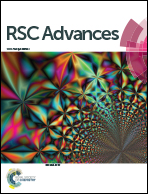Synthesis, crystal structures, and luminescent properties of Zn(ii), Cd(ii), Eu(iii) complexes and detection of Fe(iii) ions based on a diacylhydrazone Schiff base†
Abstract
Acylhydrazone Schiff bases are rich in N and O atoms to coordinate with metal ions to form multidentate complexes. In this study, a novel diacylhydrazone Schiff base (N′1E,N′4E)-N′1,N′4-bis(2-hydroxy-5-nitrobenzylidene)succinohydrazide (H4L) was synthesized from the condensation of nitrosalicylaldehyde and succinic dihydrazide. The interactions of H4L with common monovalent, divalent and trivalent metal ions were investigated by ultraviolet spectroscopy and fluorescence spectroscopy. The results showed that H4L had no obvious effect on the monovalent metal ions (Li+, Na+, K+), but reacted with most divalent and trivalent metal ions, and showed single selectivity in the fluorescence recognition of Fe3+ ions. More importantly, three kinds of binuclear molecular structures, [Zn2(H2L)2]·5DMF (Zn-L), [Cd2(H2L)2]·DMF·H2O (Cd-L) and [Eu2(H2L)3]·6DMSO (Eu-L), have been studied to further illustrate the interaction mode of diacylhydrazone Schiff base and metal ions. In addition, the optical properties of these crystallized complexes have been studied in DMF solution.



 Please wait while we load your content...
Please wait while we load your content...